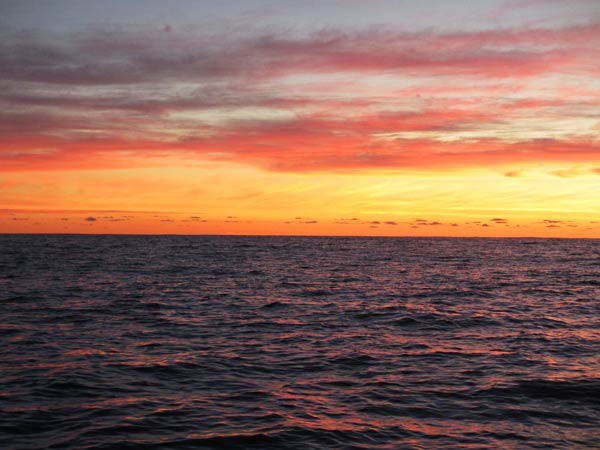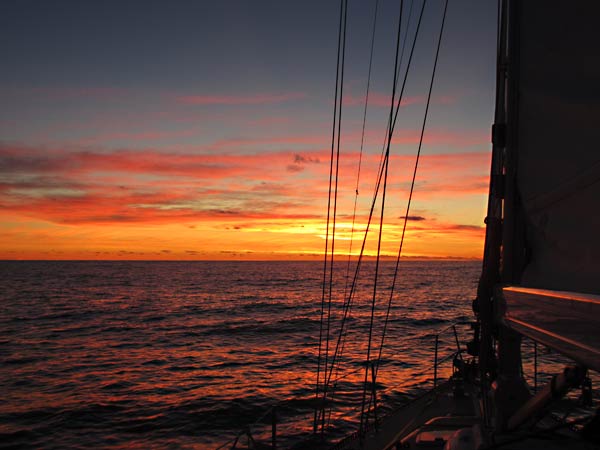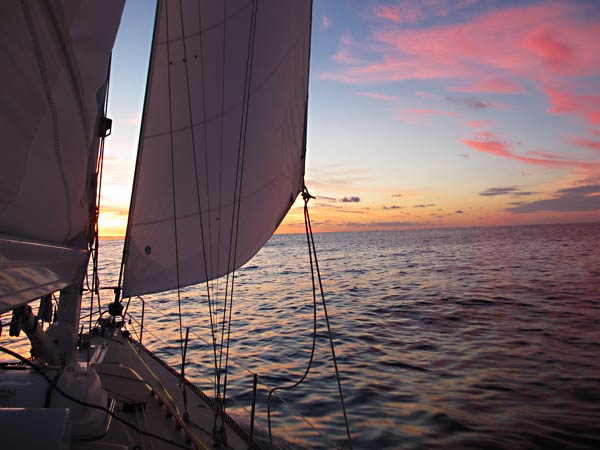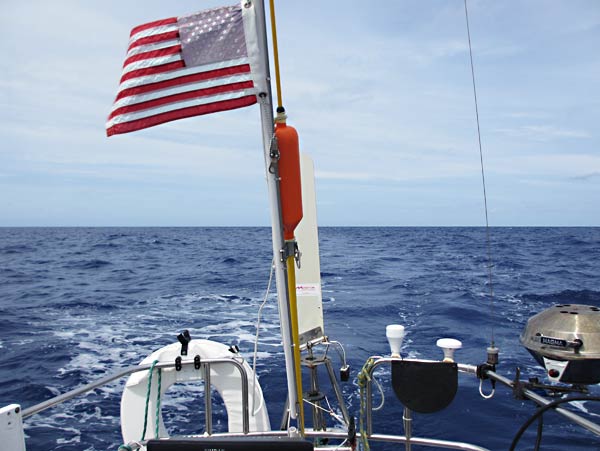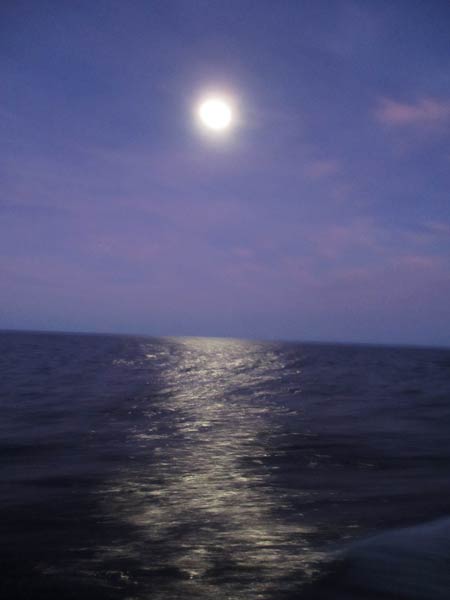November 27 – December 5, 2012
(got tied up around 2am December 6)
It’s ironic that the passage we most feared and dreaded turned out to be the easiest passage of our entire cruise. The first day was a bit bumpy but it smoothed out after that. The seas were reasonably calm. The winds were steady and moderate for the most part, occasionally boisterous or occasionally gone completely. And it stayed mostly warm up to the night we arrived! (Occasionally we’d wear sweat pants instead of shorts and eventually the down comforter was put back on the bed, but that was about it). There were days out here that were so nice, sailing along on a broad reach in gentle winds, a light swell rolling along from behind us, that I remembered why we have loved some of our passages, and why we had once even considered just taking a trip out to sea for awhile.
Unfortunately, there was a reason we could not just relax and enjoy these languorous days at sea. We hadn’t been out for even 24 hours when Sam, one of the boats in our Pacific Stragglers group, got on the net and reported seeing a low heading for New Zealand that would coincide with our arrival times. They were now en route to Minerva Reef to wait it out for a few days.
We confirmed this unwelcome news the next morning with our weather sources, including our weather router, Bob McDavitt and Gulf Harbor Radio, a group in New Zealand who do daily weather reports and advice for boats crossing to New Zealand. They were both advising the same thing: Make it in by the dinnertime on the fifth or wait it out and get in after it passed. We now had a choice to make: stop at Minerva Reef or try to beat the low to New Zealand.
Minerva Reef (aka Minerva Reefs) is a stopping point for many boats en route to and from New Zealand. It’s like a sunken atoll in the middle of the ocean. There is no land, but you can walk on the reef at low tide, and you do have to enter it through a pass just like an atoll. It is really something to experience, and something you can only do by boat.
We had certainly thought about going, but it’s one thing to wistfully think you’d like to go there someday and quite another to actually pack up and provision a boat for a long ocean voyage only to stop a couple of days out, have to anchor, unpack the dinghy and outboard, and use up provisions for the days you are there. It’s like setting out on a long road trip and stopping for the night (or in this case a few nights) just an hour down the road. You just want to keep going for awhile, and with that, we had decided not to stop. With this news, though, we had to rethink that decision.
In the end, we decided to try to beat the low. Bob McDavitt was able to route us pretty much on a straight line to New Zealand, and if we could keep a 5.6-knot average, we could probably make it in. At worst, we might get caught in the low, but with winds were predicted to be 20 to 25 knots from the north (gusts to 35), it wouldn’t be anything we couldn’t handle (we might be miserably uncomfortable, but we could handle it). With this decision, we were committing to going as fast as possible at all times, which meant when those beautiful, gentle winds came along, we needed to turn on the engine to go faster! That was the theme of our trip: Go faster, faster faster!
At this point, four of the boats in our group opted to head into Minerva Reef, and four of us decided to run for the barn. Two of the boats were the catamarans already at the front of the pack, and there was pretty much no question they would make it in before the bad weather hit. Sockdolager, a smaller sailboat, would probably have to ride out the low at sea, and Legacy may or may not beat it.
On the Tuesday, the situation became more stressful as we heard the wind might start coming from the west on Thursday. Bob told us if the winds go west, do not approach New Zealand! Well, if the winds went west we’d be right into them and could probably not approach New Zealand if we tired! We’d have to hove to. If we could keep our speed up we could make it in overnight Wednesday. We’d just have to take things as they came.
By Tuesday night we were hitting the low, but the good news was it wasn’t that bad and the winds stayed from the Northeast, 17 to 22 knots. We’d get squalls and it would get boisterous and rolly, then it would calm down. It was the same on Wednesday, boisterous and wet, but the wind speed and direction stayed the same. We felt a bit silly having to turn on our engine in 20-knot winds, but we had a slight current against us and needed to keep going as fast as we possibly could.
As it turned out, we were able to keep up our speed and entered the Bay of Islands area, New Zealand, very late Wednesday night. The winds actually lightened to 11 knots as we neared land, but the sky remained very cloudy. We had gone from looking outside every 10 minutes to a full-time watch outside as we approached the Bay of Islands. For the first time, we were cold, but never quite enough drag out the hats and shoes. We were exhausted but thrilled to have made it in before the the weather worsened and the winds became westerly (now due to happen the Thursday morning). -Cyndi
Here are some pictures from the passage…

